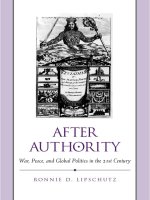Francis fukuyama state building governance and world order in the 21st century cornell university press (2004) (1)
Bạn đang xem bản rút gọn của tài liệu. Xem và tải ngay bản đầy đủ của tài liệu tại đây (8.74 MB, 158 trang )
state-building
state-building
governance
and world order
in the 21st century
f r a n c i s f u k u ya m a
cornell univer sit y press
I t h a c a , N e w Yo r k
Copyright © 2004 by Francis Fukuyama
All rights reserved. Except for brief quotations in a review, this
book, or parts thereof, must not be reproduced in any form without
permission in writing from the publisher. For information, address
Cornell University Press, Sage House, 512 East State Street, Ithaca,
New York 14850.
First published 2004 by Cornell University Press
Printed in the United States of America
Library of Congress Cataloging-in-Publication Data
Fukuyama, Francis.
State-building : governance and world order in the 21st century /
Francis Fukuyama.
p. cm.
Includes bibliographical references and index.
ISBN 0-8014-4292-3 (cloth : alk. paper)
1. State, The. 2. National state. I. Title.
JA66.F85 2004
320.1—dc22
2004000905
Cornell University Press strives to use environmentally responsible
suppliers and materials to the fullest extent possible in the publishing of its books. Such materials include vegetable-based, low-VOC
inks and acid-free papers that are recycled, totally chlorine-free, or
partly composed of nonwood fibers. For further information, visit
our website at www.cornellpress.cornell.edu.
Cloth printing
10 9 8 7 6 5 4 3 2 1
To Marty Lipset
contents
Preface
1
The Missing Dimensions of Stateness
1
The Contested Role of the State
3
Scope versus Strength
2
ix
6
Scope, Strength, and Economic Development
15
The New Conventional Wisdom
21
The Supply of Institutions
23
The Demand for Institutions
32
Making Things Worse
39
Weak States and the Black Hole of Public Administration
43
Institutional Economics and the Theory
of Organizations
The Ambiguity of Goals
45
51
Principals, Agents, and Incentives
55
Decentralization and Discretion
67
Losing, and Reinventing, the Wheel
76
Capacity-Building under Conditions of
Organizational Ambiguity: Policy Implications
82
viii
state-building
3
Weak States and International Legitimacy
92
The New Empire
94
The Erosion of Sovereignty
96
Nation-Building
4
99
Democratic Legitimacy at an International Level
104
Beyond the Nation-State
114
Smaller but Stronger
119
Bibliography
123
Index
133
preface
S
tate-building is the creation of new government institutions and the strengthening of existing ones. In this
book I argue that state-building is one of the most important
issues for the world community because weak or failed
states are the source of many of the world’s most serious
problems, from poverty to AIDS to drugs to terrorism. I also
argue that while we know a lot about state-building, there is
a great deal we don’t know, particularly about how to transfer strong institutions to developing countries. We know
how to transfer resources across international borders, but
well-functioning public institutions require certain habits of
mind and operate in complex ways that resist being moved.
We need to focus a great deal more thought, attention, and
research on this area.
The idea that state-building, as opposed to limiting or cutting back the state, should be at the top of our agenda may
strike some people as perverse. The dominant trend in world
politics for the past generation has been, after all, the critique
of “big government” and the attempt to move activities from
the state sector to private markets or to civil society. But parix
x
preface
ticularly in the developing world, weak, incompetent, or nonexistent government is the source of severe problems.
For example, the AIDS epidemic in Africa has infected more
than 25 million people and will take a staggering toll of lives.
AIDS can be treated, as it has been in the developed world,
with antiretroviral drugs. There has been a strong push to provide public funding for AIDS medicine or to force pharmaceutical companies to permit the marketing of cheaper forms of
their products in Africa and other parts of the Third World.
While part of the AIDS problem is a matter of resources, another important aspect is government capacity to administer
health programs. Antiretroviral drugs are not only expensive,
they also are complex to administer. Unlike a one-shot vaccine, they must be taken in complex doses over a long period of
time; failure to follow the regimen may actually make the epidemic worse by allowing the human immunodeficiency virus
to mutate and develop drug resistance. Effective treatment requires a strong public health infrastructure, public education,
and knowledge about the epidemiology of the disease in specific regions. Even if the resources were there, the institutional
capacity to treat the disease is lacking in many countries in
sub-Saharan Africa (though some, like Uganda, have done a
much better job than others). Dealing with this epidemic thus
requires helping afflicted countries develop the institutional
capacity to use what resources they may acquire.
Lack of state capacity in poor countries has come to haunt
the developed world much more directly. The end of the Cold
War left a band of failed and weak states stretching from the
Balkans through the Caucasus, the Middle East, Central Asia,
and South Asia. State collapse or weakness had already created
major humanitarian and human rights disasters during the
1990s in Somalia, Haiti, Cambodia, Bosnia, Kosovo, and East
Timor. For a while, the United States and other countries
could pretend these problems were just local, but September
preface
xi
11 proved that state weakness constituted a huge strategic
challenge as well. Radical Islamist terrorism combined with
the availability of weapons of mass destruction added a major
security dimension to the burden of problems created by weak
governance. The United States has taken on major new responsibilities for nation-building in Afghanistan and Iraq in the
wake of military actions there. Suddenly the ability to shore
up or create from whole cloth missing state capabilities and institutions has risen to the top of the global agenda and seems
likely to be a major condition for security in important parts of
the world. Thus state weakness is both a national and an international issue of the first order.
This book has three main parts. The first lays out an analytical framework for understanding the multiple dimensions of
“stateness”—that is, the functions, capabilities, and grounds
for legitimacy of governments. This framework will explain
why, in most developing countries, states are not too strong
but rather too weak. The second part looks at the causes of
state weakness, particularly why there can be no science of
public administration despite recent efforts by economists to
establish one. This lack sharply limits the ability of outsiders
to help countries strengthen their state capacity. The final part
discusses the international dimensions of state weakness: how
instability is driven by state weakness, how weakness has
eroded the principle of sovereignty in the international system,
and how questions of democratic legitimacy on an international level have come to dominate disputes between the
United States, Europe, and other developed countries in the international system.
This book is based on the Messenger Lectures I delivered at
Cornell University in Ithaca, New York, February 18–21, 2003.
I am very grateful to Cornell, my undergraduate alma mater,
and its former president, Hunter Rawlings, for inviting me to
return and deliver this prestigious series. I particularly appreci-
xii
preface
ate the efforts of Victor Nee of the Sociology Department at
Cornell to facilitate the lecture series and host me at the newly
formed Center for the Study of Economy and Society and those
of the Center’s associate director, Richard Swedberg.
Parts of Chapter 3 were given as the John Bonython lecture
in Melbourne, Australia, and the Sir Ronald Trotter Lecture
delivered in Wellington, New Zealand, both in August 2002. I
am grateful to the Centre for Independent Studies and its director, Greg Lindsey, and to Roger Kerr and Catherine Judd of
the New Zealand Business Roundtable for helping bring my
family and me to their part of the world. Owen Harries, former
editor of The National Interest, also provided valuable comments on the lecture.
Many of the ideas in this book came from a graduate course
on comparative politics that I taught with Seymour Martin
Lipset over a period of several years at the School of Public Policy at George Mason University. I have learned an enormous
amount from Marty Lipset over the years, and it is to him that
this book is dedicated.
I received helpful comments and advice from a number of
friends and colleagues, including Roger Leeds, Jessica Einhorn,
Fred Starr, Enzo Grilli, Michael Mandelbaum, Robert Klitgaard, John Ikenberry, Michael Ignatieff, Peter Boettke, Rob
Chase, Martin Shefter, Jeremy Rabkin, Brian Levy, Gary
Hamel, Liisa Välikangas, Richard Pascale, Chet Crocker, Grace
Goodell, Marc Plattner, and Karen Macours.
Parts of the lectures on which the book is based were also
given at the Inter-American Development Bank and the U.S.
Agency for International Development; I would like to thank
Enrique Iglesias, president of the IDB, and Ann Phillips of
USAID’s Bureau for Policy and Program Coordination for facilitating these events. Presentations of parts of Chapter 3 were
also made at the Miller Center at the University of Virginia,
the Carr Center at Harvard’s Kennedy School of Government,
preface
xiii
the Transatlantic Center at SAIS, the Maxwell School at Syracuse University, and the German Marshall Fund.
My research assistants Matthias Matthijs, Krisztina Csiki,
Matt Miller, and particularly Björn Dressel provided great assistance in putting together materials for the book. My assistant, Cynthia Doroghazi, was helpful in many different phases
of the project.
As always, I thank my family for their support through the
writing of this book.
state-building
1
the missing dimensions
o f stat e n e s s
T
he state is an ancient human institution dating back
some 10,000 years to the first agricultural societies that sprang
up in Mesopotamia. In China a state with a highly trained bureaucracy has existed for thousands of years. In Europe the
modern state, deploying large armies, taxation powers, and a
centralized bureaucracy that could exercise sovereign authority over a large territory, is much more recent, dating back four
or five hundred years to the consolidation of the French, Spanish, and Swedish monarchies. The rise of these states, with
their ability to provide order, security, law, and property rights,
was what made possible the rise of the modern economic
world.
States have a wide variety of functions, for good and ill. The
same coercive power that allows them to protect property
rights and provide public safety also allows them to confiscate
private property and abuse the rights of their citizens. The monopoly of legitimate power that states exercise allows individuals to escape what Hobbes labeled the “war of every man
against every man” domestically but serves as the basis for
conflict and war at an international level. The task of modern
1
2
state-building
politics has been to tame the power of the state, to direct its
activities toward ends regarded as legitimate by the people it
serves, and to regularize the exercise of power under a rule of
law.
Modern states in this sense are anything but universal. They
did not exist at all in large parts of the world like sub-Saharan
Africa before European colonialism. After World War II decolonization led to a flurry of state-building all over the developing
world, which was successful in countries like India and China
but which occurred in name only in many other parts of
Africa, Asia, and the Middle East. The last European empire to
collapse—that of the former Soviet Union—initiated much the
same process, with varying and often equally troubled results.
The problem of weak states and the need for state-building
have thus existed for many years, but the September 11 attacks
made them more obvious. Poverty is not the proximate cause
of terrorism: The organizers of the attacks on the World Trade
Center and the Pentagon on that date came from middle-class
backgrounds and indeed were radicalized not in their native
countries but in Western Europe. However, the attacks brought
attention to a central problem for the West: The modern world
offers a very attractive package, combining the material prosperity of market economies and the political and cultural freedom of liberal democracy. It is a package that very many
people in the world want, as evidenced by the largely one-way
flows of immigrants and refugees from less-developed to moredeveloped countries.
But the modernity of the liberal West is difficult to achieve
for many societies around the world. While some countries in
East Asia have made this transition successfully over the past
two generations, others in the developing world have either
been stuck or have actually regressed over this period. At issue
is whether the institutions and values of the liberal West are
indeed universal, or whether they represent, as Samuel Huntington (1996) would argue, merely the outgrowth of cultural
the missing dimensions of stateness
3
habits of a certain part of the northern European world. The
fact that Western governments and multilateral development
agencies have not been able to provide much in terms of useful
advice or help to developing countries undercuts the higher
ends they seek to foster.
The Contested Role of the State
It is safe to say that politics in the twentieth century were
heavily shaped by controversies over the appropriate size and
strength of the state. The century began with a liberal world
order presided over by the world’s leading liberal state, Great
Britain. The scope of state activity was not terribly broad in
Britain or any of the other leading European powers, outside of
the military realm, and in the United States, it was even narrower. There were no income taxes, poverty programs, or food
safety regulations. As the century proceeded through war, revolution, depression, and war again, that liberal world order
crumbled, and the minimalist liberal state was replaced
throughout much of the world by a much more highly centralized and active one.
One stream of development lead to what Friedrich and
Brzezinski (1965) labeled the “totalitarian” state, which tried
to abolish the whole of civil society and subordinate the remaining atomized individuals to its own political ends. The
right-wing version of this experiment ended in 1945 with the
defeat of Nazi Germany, while the left-wing version crumbled
under the weight of its own contradictions when the Berlin
Wall fell in 1989.
The size, functions, and scope of the state increased in nontotalitarian countries as well, including virtually all democracies during the first three-quarters of the twentieth century.
While state sectors at the beginning of the century consumed
little more than 10 percent of gross domestic product (GDP) in
4
state-building
most Western European countries and the United States, they
consumed nearly 50 percent (70 percent in the case of social
democratic Sweden) by the 1980s.
This growth, and the inefficiencies and unanticipated consequences it produced, led to a vigorous counterreaction in the
form of “Thatcherism” and “Reaganism.” The politics of the
1980s and 1990s were characterized by the reascendance of liberal ideas throughout much of the developed world, along with
attempts to hold the line, if not reverse course, in terms of
state-sector growth (Posner 1975). The collapse of the most extreme form of statism, communism, gave extra impetus to the
movement to reduce the size of the state in noncommunist
countries. Friedrich A. Hayek, who was pilloried at midcentury for suggesting that there was a connection between totalitarianism and the modern welfare state (Hayek 1956), saw his
ideas taken much more seriously by the time of his death in
1992—not just in the political world, where conservative and
center-right parties came to power, but in academia as well,
where neoclassical economics gained enormously in prestige
as the leading social science.
Reducing the size of the state sector was the dominant
theme of policy during the critical years of the 1980s and early
1990s, when a wide variety of countries in the former communist world, Latin America, Asia, and Africa were emerging
from authoritarian rule after what Huntington (1991) labeled
the “third wave” of democratization. There was no question
that the all-encompassing state sectors of the former communist world needed to be dramatically scaled back, but state
bloat had infected many noncommunist developing countries
as well. For example, the Mexican government’s share of GDP
expanded from 21 percent in 1970 to 48 percent in 1982, and
its fiscal deficit reached 17 percent of GDP, laying the groundwork for the debt crisis that emerged that year (Krueger 1993,
11). The state sectors of many sub-Saharan African countries
engaged in activities like running large state-owned corpora-
the missing dimensions of stateness
5
tions and agricultural marketing boards that had negative effects on productivity (Bates 1981, 1983).
In response to these trends, the advice offered by international financial institutions (IFIs) like the International Monetary Fund (IMF) and World Bank, as well as by the U.S. government, emphasized a collection of measures intended to reduce
the degree of state intervention in economic affairs—a package
designated as the “Washington consensus” by one of its formulators (Williamson 1994) or as “neoliberalism” by its detractors in Latin America. The Washington consensus has
been relentlessly attacked in the early twenty-first century,
not just by antiglobalization protesters but also by academic
critics with better credentials in economics (see Rodrik 1997;
Stiglitz 2002).
In retrospect, there was nothing wrong with the Washington
consensus per se: The state sectors of developing countries
were in very many cases obstacles to growth and could only be
fixed in the long run through economic liberalization. Rather,
the problem was that although states needed to be cut back in
certain areas, they needed to be simultaneously strengthened
in others. The economists who promoted liberalizing economic reform understood this perfectly well in theory. But the
relative emphasis in this period lay very heavily on the reduction of state activity, which could often be confused or deliberately misconstrued as an effort to cut back state capacity
across the board. The state-building agenda, which was at least
as important as the state-reducing one, was not given nearly as
much thought or emphasis. The result was that liberalizing
economic reform failed to deliver on its promise in many
countries. In some countries, indeed, absence of a proper institutional framework left them worse off after liberalization
than they would have been in its absence. The problem lay in
a basic conceptual failure to unpack the different dimensions
of stateness and to understand how they related to economic
development.
6
state-building
Scope versus Strength
I begin the analysis of the role of the state in development by
posing this question: Does the United States have a strong or
weak state? One clear-cut answer is that given by Lipset
(1995): American institutions are deliberately designed to
weaken or limit the exercise of state power. The United States
was born in a revolution against state authority, and the resulting antistatist political culture was expressed in constraints on state power like constitutional government with
clear-cut protections for individual rights, the separation of
powers, federalism, and so forth. Lipset points out that the
American welfare state was established later and remains
much more limited (e.g., no comprehensive health care system) than those of other developed democracies, that markets
are much less regulated, and that the United States was in the
forefront of rolling back its welfare state in the 1980s and
1990s.
On the other hand, there is another sense in which the
American state is very strong. Max Weber (1946) defined the
state as “a human community that (successfully) claims the
monopoly of the legitimate use of physical force within a
given territory.” The essence of stateness is, in other words,
enforcement: the ultimate ability to send someone with a uniform and a gun to force people to comply with the state’s laws.
In this respect, the American state is extraordinarily strong: It
has a plethora of enforcement agencies at federal, state, and
local levels to enforce everything from traffic rules to commercial law to fundamental breaches of the Bill of Rights. Americans, for various complex reasons, are not a law-abiding people
when compared to citizens of other developed democracies
(Lipset 1990), but not for want of an extensive and often highly
punitive criminal and civil justice system that deploys substantial enforcement powers.
the missing dimensions of stateness
7
The United States, in other words, has a system of limited
government that has historically restricted the scope of state
activity. Within that scope, its ability to create and enforce
laws and policies is very strong. There is, of course, a great deal
of justified cynicism on the part of many Americans about the
efficiency and sensibility of their own government (see, for example, Howard 1996). But the American rule of law is the envy
of much of the rest of the world: Those Americans who complain about how their local department of motor vehicles
treats motorists should try getting a driver’s license or dealing
with a traffic violation in Mexico City or Jakarta.
It therefore makes sense to distinguish between the scope of
state activities, which refers to the different functions and
goals taken on by governments, and the strength of state
power, or the ability of states to plan and execute policies and
to enforce laws cleanly and transparently—what is now commonly referred to as state or institutional capacity. One of the
confusions in our understanding of stateness is that the word
strength is often used indifferently to refer both to what is here
labeled scope as well as to strength or capacity.
Distinguishing between these two dimensions of stateness
allows us to create a matrix that helps differentiate the degrees
of stateness in a variety of countries around the world. We can
array the scope of state activities along a continuum that
stretches from necessary and important to merely desirable to
optional, and in certain cases counterproductive or even destructive. There is of course no agreed-on hierarchy of state
functions, particularly when it comes to issues like redistribution and social policy. Most people would agree that there has
to be some degree of hierarchy: States need to provide public
order and defense from external invasion before they provide
universal health insurance or free higher education. The World
Bank’s 1997 World Development Report (World Bank 1997)
provides one plausible list of state functions, divided into three









